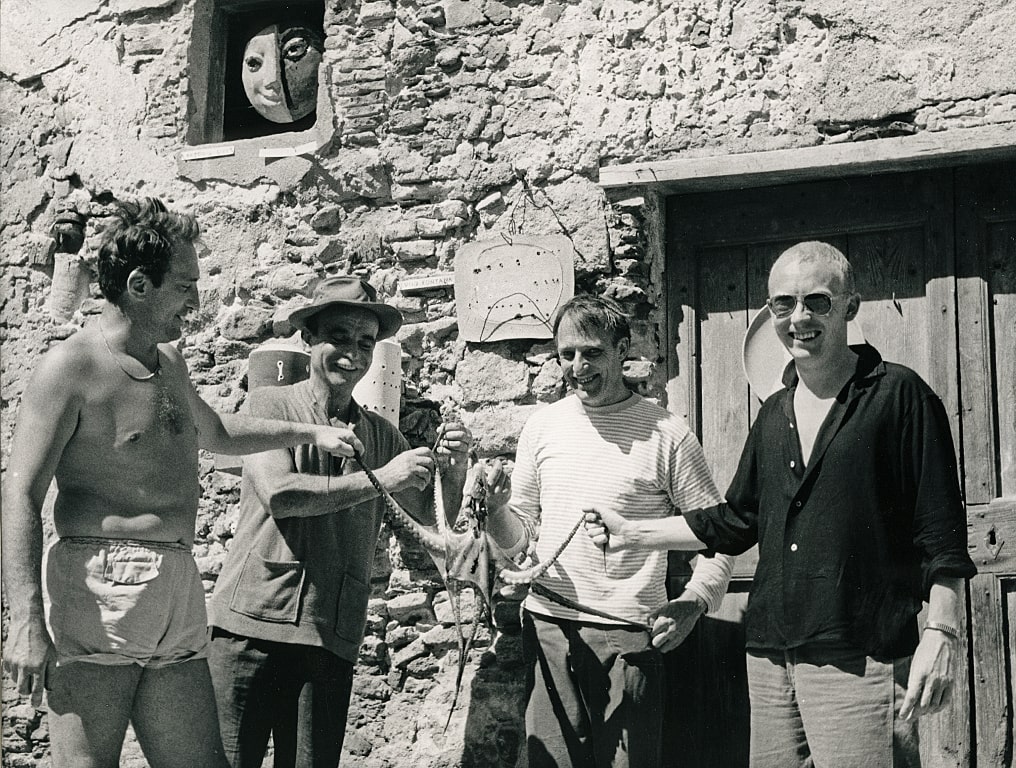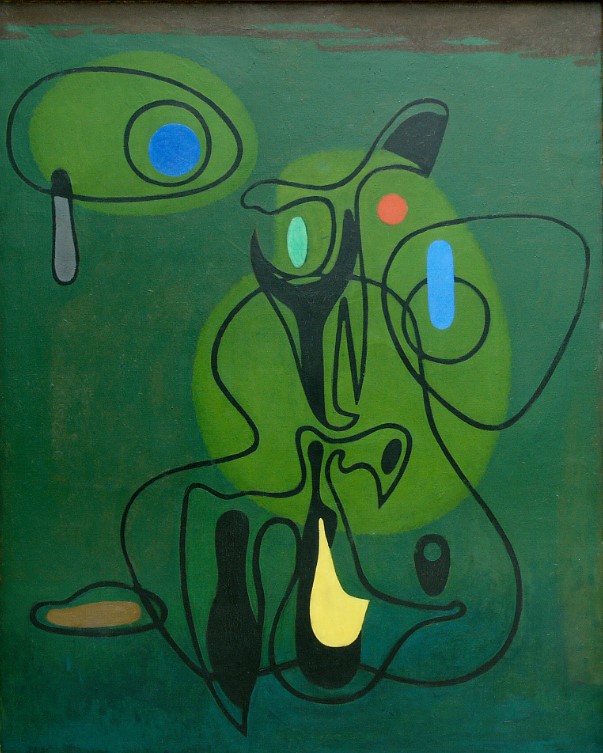Search

ASGER JORN
1914 - 1973
One of Scandinavia's most influential and internationally recognized artists
Jorn was a networking person and the driving force behind several art associations. Among other things, he was one of the main figures behind the magazine Helhesten, he co-founded the art movement CoBrA, MIBI (Mouvement Internationale pour un Bauhaus Imaginiste) and Situationist International.
Jorn developed the spontaneous-abstract imagery and explored painting, drawing, collage, graphics, ceramics and image weaving as artistic forms of expression. In addition, he published 23 books, contributed to the publication of a number of art magazines and wrote numerous articles.
Museum Jorn’s collections today contain the world’s largest collection of Asger Jorn’s works: more than 150 paintings, all 530 of his graphic works as well as weavings, ceramic works, bronze sculptures, drawings and approx. 25,000 photos from the SISV-project in addition to an extensive archive of letters, manuscripts, sketchbooks, etc.













1914
1936
1940
1942
1948
1952
1953
1957
1959
1961
1964
1968
1972
1914
FAMILY AND TEACHER
Asger Oluf Jørgensen was born on 3 March 1914 in Vejrum in the western part of Jutland. Both parents were teachers and, following the early death of his father, his mother Maren Jørgensen moved to Silkeborg with her six children. Jorn attended teacher training college here, joined the boy scouts, and his association with the syndicalist Christian Christensen sharpened his political commitment. On and off during his life, Jorn was a member of the Communist Party, but developing a very personal and independent political stance. He was taught by the painter Martin Kaalund Jørgensen and had his first show at the exhibition by Frie Jyske Malere (Free Jutlandic Painters) in 1933 with three pictures.
1936
MODERN ART IN PARIS
Jorn drove his motorbike to Paris where he applied to study at Fernand Léger’s school of painting. Here he met the French artist Pierre Wemaëre. They learned to discipline their work and master the composition of picture planes. Jorn worked for Le Corbusier at the World Exhibition in 1937. The following years, he returned to Paris, but spent the winter season at the Royal Academy of Fine Arts in Copenhagen. In 1938 Jorn travelled briefly to Norway in the company of Pierre Wemaëre before continuing at the Royal Danish Academy of Fine Arts. In 1939, Jorn married his student sweetheart Kirsten Lyngborg, whom he had three children with; Klaus, Susanne and Troels.
1940
HELHESTEN
During the German Occupation, Jorn published the journal Helhesten in conjunction with Egill Jacobsen, Ejler Bille, Carl-Henning Pedersen, and the architect Robert Dahlmann Olsen. This was a comprehensive journal and the articles covered everything from African masks and Nordic folk art to jazz, Surrealism, and children’s drawings. All of it intended to provoke the German occupational power. Concurrently with this, the artists evolved a spontaneous-abstract idiom.
1942
ART AND ARCHITECTURE
Jorn began writing about the relationship between art, architecture, and life. He collaborated with various architects and executed a number of decorations. He painted black-out panels for the architect Marinus Andersen’s flat and designed a proposal for a decoration for a wine merchant. He allowed paintings and reliefs to populate the walls both inside and out in the art collector Elna Fonnesbech-Sandberg’s summer house, and together with the artists from Helhesten, he decorated a kindergarten in Hjortøgade in Copenhagen. Jorn evolved his own Nordic contribution to the Parisian discussion on the synthesis of the arts.
On August 25, 1945, Asger Oluf Jørgensen changed his name to Asger Jorn, which went down better abroad. The same year Jorn entered Norway illegally to see the big retrospective Munch exhibition at the National Gallery. The exhibition made a deep impression on him. He looked up the author Pola Gauguin who was writing a new biography of Munch. The following year, he visited Picasso in Antibes in Southern France.
1948
COBRA
In the autumn of 1948, Jorn established Cobra: Copenhague, Brussels and Amsterdam together with the Belgian poet Christian Dotremont and the Dutchmen Karel Appel, Constant, and Corneille. The group also included the spontaneous-abstract Danish artists from the artists’ group Helhesten. During a conference at Bregnerød in 1949, the artists painted the walls and ceiling in the weekend cabin frequented by architect students. The Dutch artists stayed away in protest, since Jorn and Constant’s wife Matie van Domselaer had started a relationship. They married in 1950 and had two children; Ole and Bodil. Later, some of the Cobra artists also painted the potter Erik Nyholm’s house in Funder. Cobra was dissolved in 1951.
1952
SILKEBORG
Jorn was living in the Danish House in Paris with his family. Sick and exhausted from tuberculosis, he returned in 1952 to Silkeborg where he was admitted to the local sanatorium. Soon after, he began to paint, e.g. the two monumental paintings Af den stumme myte (On the Silent Myth) for Silkeborg Municipal Library. He wrote the book Held og hasard (Fortune and the Game of Chance), which he submitted to the University of Copenhagen hoping to have it approved as a thesis. But it was dismissed on the grounds of being unscholarly.
1953
CERAMIC ART
Jorn worked in clay with the potter Knud Jensen in Sorring. 22 works from here constituted the beginnings of the huge donation of 5,500 works of art which he donated to the town of Silkeborg over the next 20 years. In 1953, he executed 21 light drawings on the request of the photographer Poul Pedersen. After a few months in Switzerland, he went to the Italian coastal town of Albissola near Genoa. Shortly after his arrival, he set up an international festival of fire and clay. From then on, Jorn spent the summer months in Albissola and the winters in Paris.
1957
INTERNATIONAL SITUATIONISM OG BREAKTHROUGH
In 1957, Jorn established the experimental and revolutionary artistic movement Situationistisk Internationale (SI) (International Situationists) in conjunction with Pinot Gallizio, Guy Debord, Michèle Bernstein, and Ralph Rumney. Jorn published the book Pour la forme (1957), in it outlining his artistic and theoretical considerations. Jorn and Debord created the artists’ books Fin de Copenhague (1957) and Mémoires (1959). In 1958 Jorn’s painting Lettre à mon fils, was displayed at the World’s Fair in Brussels. This was Jorn’s international breakthrough.
1959
AARHUS STATSGYMNASIUM
In Albissola, in the summer of 1959, he worked on a relief measuring 27 m x 3 m for the sixth-form college Aarhus Statsgymnasium. Concurrently with this, the execution of a 14 m tapestry: Den lange rejse (The Long Journey) was begun in Paris supervised by Pierre Wemaëre and himself – for the same college.
1961
SISV
Jorn resumed his old plan of a grand presentation of ancient Nordic art in book form. This resulted in an archive containing more than 25,000 photos by the French photographer Gérard Franceschi. Jorn had the idea that these archives would evolve into a study centre of ancient Nordic art: Skandinavisk Institut for Sammenlignende Vandalisme (SISV) (Scandinavian Institute for Comparative Vandalism). Jorn published Value and Economy in 1962. From May to June 1963 Jorn travelled round Norway with Franceschi to collect photographic material to illustrate 10,000 years of Nordic folk art, with particular focus on the stave churches round Bergen and Kaupanger.
1964
MUSEUM BUILDINGS AND INTERNATIONAL EXHIBITIONS
In 1964, the world-renowned Danish architect Jørn Utzon presented his first proposal for a museum to house Jorn’s collection in Silkeborg. Jorn had himself wanted Utzon to design the building, but neither of the two final projects were ever realised. In 1964, Jorn took part in a number of international art exhibitions and his first retrospective exhibition took place in Basel, Amsterdam, and at Louisiana near Copenhagen. Jorn refused the Guggenheim award. In 1965, he had to abandon the SISV project, but published several books on selected topics later. During the New Year 1966-67, he executed a number of large lithographs in Switzerland. In September of that year Jorn took part in a travelling exhibition in Oslo, Bergen, Trondheim and Gothenborg. He went on to travel round Norway and Sweden in order to seek out potential contributors to the book series about 10,000 years of Nordic folk art. A list of authors for a total of 28 volumes was settled upon.
1968
WALL PAINTINGS
Jorn participated in a cultural conference in Havana, Cuba, at which occasion his painting Stalingrad was shown. Instead of taking part in the discussions, Jorn spent the time adorning the walls of the Archive of the Revolution. In 1969 Jorn went to Oslo where he researched the legend of the Gothic King Didrik in both pictures and words. Jorn was particularly interested in the relationship between myth as narrative and image as myth. It was on this occasion that he presented his hypothesis of image being prior to myth. In 1970 Jorn travelled to New York, Las Vegas, Hawaii, Kyoto, Tokyo, Hong Kong, New Delhi, Teheran, Beirut og Baalbek. He was showing regularly at galleries in Munich, Copenhagen, London, New York, and Milan. Jorn and Noël Arnaud published the book La Langue verte et la cuite , the so-called Tongue Book.
1972
TYE FINAL YEARS
In Albissola, Jorn spent the summer 1972 working on a series of clay sculptures that were later cast in bronze. He went to Denmark where he was planning a two-volume work on Theoderik, king of the Goths, and Didrik, his opposite number in the Nordic sagas. In January 1973, he was admitted to Aarhus District General Hospital. He married Nanna Enzensberger, whom he had the son Ib with. In early April, he went to Albissola confirming that he would hand over his property to the town while ensuring that his friend Umberto Gambetta and his wife could stay in the house for the rest of their lives. Jorn died in Aarhus on 1 May 1973. He is buried on Grötlingbo Cemetery in Gotland.
Selected works from Asger Jorn


Asger Jorn
Skildpadden I, 1938


Asger Jorn
Menacing train signals on the way to Versailles, 1939


Asger Jorn
Minder passerer revy, 1971


Asger Jorn
The moon dog, 1953


Asger Jorn
Broderskab fremfor alt (Fraternité avant tout), 1962


Asger Jorn
Sådan var du (Tu étais tel), 1956


Asger Jorn
Den foruroligende ælling (Le canard inquiétant), 1959
